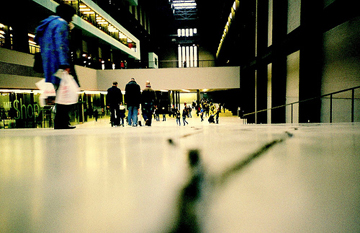
Tate Modern’s Turbine Hall commissions have set a certain standard for scale in art making at a time when many artists have retreated from the big, brash statement towards the self-effacing, the handmade, the infra-mince. The hall itself is the former home of the electricity generators, and it’s as soaring and belittling as the nave of a Gothic cathedral. Linking as it does all of the floors of the galleries, it functions both as prologue and nervous system for the entire permanent collection. You see it everywhere. Kids skid down its vast concrete tongue on wheeled sneakers, people take pictures of their babies wriggling on the floor, old couples sneak in sandwiches and hide behind the columns. As locus for what Tate Modern means for art, the Turbine Hall says it all: open, casual, self-consciously relaxed. The Turbine Hall commissions set the scene and provide a definition of contemporary art for the thousands of visitors that leans somewhat on the post-Sensation notion that art should be big, performative, demonstrative. It’s that reliance on overwhelming scale, gross-out nastiness, and audience participation that draws the crowds.
It’s instructive to compare this space with MoMA’s atrium. Both serve as nave-equivalents that spin off into quieter areas of contemplation, but it’s notable that MoMA’s pristine atrium sets a hushed and somewhat churchy tone that carries through in the installation of works (canonical and chronological), while the Turbine Hall suggests an irreverence and friendliness that is picked up in the whimsical installations of art and dayglo plastic chairs in the café. Both approaches have their faults: at MoMA, the tasteful neatness of Taniguchi’s galleries chastises messiness like a prissy primary school teacher (Philip Guston looks like an example to the class of what not to do, children); at Tate Modern, cleanliness and tidiness looks mean-spirited and non-participatory–Donald Judd’s brass box is smeared with fingerprints, the square guy who won’t dance at the party.
By its nature, the Turbine Hall demands the showboat, but the most effective of its commissions have been ones that challenge rather than comply with its bullish vastness. Bruce Nauman’s installation in 2004, Raw Materials, consisted of a number of speakers set along the walls of the space, which played snippets of sound from his back catalogue, a brilliant play on language’s ability to both unite and divide. Juan Muñoz’s Double Bind set false floors into the hall to mine areas of theatricality and illusionism with unsettling effect. What distinguishes these works is that the space provided a frame for a continuation of themes within the artists’ work as a whole. The setting serves both artists’ concerns with the slipperiness of language and the theatricality of art. Other artists haven’t fared as well, their works either compromised by the space (Rachel Whiteread’s Embankment, stacks of cast cardboard boxes that lacked the emotional punch a smaller space would have provided) or flawed by choosing to square up to its epic scale.
The current occupant, Dominique Gonzalez-Foerster’s TH.2058, is a good example of the latter. Gigantic replicas of well-known works of public sculpture–by Louise Bourgeois, Alexander Calder, Henry Moore, Nauman, Maurizio Cattelan and Claes Oldenburg–squat over the end of the hall, whose floor is occupied by rows of blue and yellow metal bunk beds with works of apocalyptic fiction scattered on them (Sebald, Ballard, Huxley). Gonzalez-Foerster’s narrative (patiently explained in the wall labels) is that, fifty years into the future, endless rain will cause public sculptures to grow and become Godzilla-like monsters that will need to be contained inside. This is a conceit the artist explored in reduced scale in her Sculpture Munster project last year, but here it looks as though the space has won again. The apocalyptic narrative looks less convincing in the context of global economic meltdown, and the works feels like a weak art in-joke, a flailing attempt to draw attention. Paired with the outstanding show of late Rothko paintings the installation looks like artistic endgame: a self-regarding gambit for cheap laughs versus a hard-won exploration of things beyond experience. It felt like an indictment, a real challenge.




Pingback: Letter from London: Pumping Irony | Art21 Blog